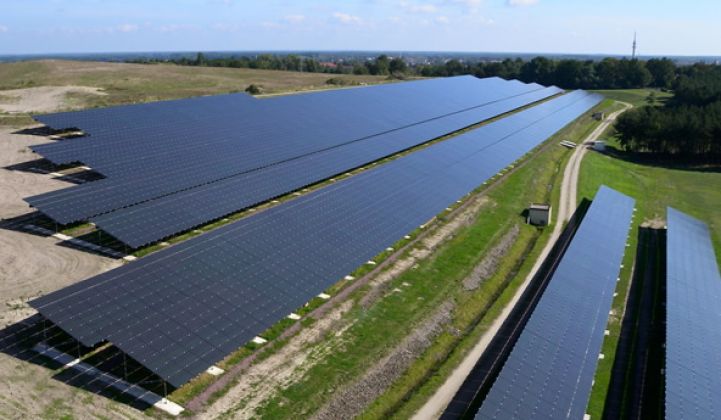Nanosolar, the CIGS (CuInGaSe) solar module aspirant, has been cutting a lower profile compared to its brash early years.
The 300-employee, San Jose, California-based firm has reset its management team with a focus on operations and seems to be making some progress on the technical and commercial fronts.
As one of the first wave of capital-intensive, VC-funded, next-generation thin-film solar companies, the company raised a lot of cash (more than $400 million in private equity) but was prone to over-promising and under-delivering. Faced with an economic slowdown, a precipitous decline in global module pricing, a bit of boardroom carnage that brought in a new CEO (Geoff Tate, formerly of Rambus and AMD) -- the firm stayed relatively quiet in 2010 and regrouped. (Tom Cheyney of PV-Tech did get an audience with the firm in their most notable press account of 2010.)
The new CEO told me, "We've made huge progress; we've grafted an operations process onto the company."
Nanosolar has re-emerged in its 2011 incarnation, presumably a bit humbled, but set on having 115 megawatts of capacity online by the end of the year. What bluster remains in the company comes in the form of an ambitious cost and efficiency roadmap with these goals:
- Below $1.00 per watt factory cost by the end of this year
- Low $0.80s or high $0.70s per watt by late next year
- In the $0.60s in 2013
- Below $0.60 per watt in 2014
Our analyst team estimates their current cost in the $1.35 per watt range. Tate suggested that cost reduction will come from improved sourcing, ramping yields, growing volume to spread the overhead across more units, and optimizing the recipe.
Nanosolar produced 2.5 megawatts of panels last year. This year they'll ship "double digit" megawatts and "triple digits" in 2012, according to the CEO. Cell production capacity will be 115 megawatts by the end of 2011 and the next step jumps the firm to 250 megawatts of cell capacity in San Jose. Panel assembly is performed at their factory in Luckenwalde, Germany.
The firm is shipping 10 percent efficiency panels today with a target of 12 percent efficiency next year. Expectations are for 13 percent in 2013 and 14 percent in 2014. Tate joked that he'd like to keep the trend going to 99 percent efficiency in 2099. In any case, a 4 percentage point increase in efficiency in four years would be unprecedented by any solar firm.
The company is focused solely on utility-scale deployments. Their large utility-size panels are currently rated at 200 watts with output gains expected as efficiency rises. Brian Stone, the VP of Sales and Marketing, maintains that the edge box, low voltage, and size of the Nanosolar panels lend themselves to reductions in balance of systems (BoS) costs and incur less of a BoS penalty than do other lower-efficiency panels.
Nanosolar announced that they have signed long-term supply agreements for up to one gigawatt of PV panels with Belectric of Kolitzheim, Germany; EDF Energies Nouvelles of Paris, France; and Plain Energy of Munich, Germany.
Take that "long-term supply agreement" lingo with a grain of salt. These contracts are not binding, are not take-or-pay, and are based on Nanosolar achieving its cost and efficiency targets. Although those agreements don't translate as real backlog, they do translate to patient customers who appear willing to work with Nanosolar. Nanosolar, as a new supplier without a field performance track record, employs module warranty insurance to help financiers and customers feel comfortable and improve their bankability.
The Factory Tour
Nanosolar’s roll-to-roll printing process potentially lets the company benefit from low capital expenditure and high throughput. Nanosolar operates the roll-to-roll solar cell printing factory in San Jose, California and Stone and Ravi Balaji, VP Cell Operations, gave me the tour.
The CEO said, "We're not a CIGS company like all the rest."
The emphasis is clearly on the roll-to-roll process and the printing model in this factory as one watches the 1,200-meter-long foil spools transported from process to process. There is a vacuum printing process for the bottom electrode and the top conductor, but the application of the nanoparticle CIG ink is what one would imagine a printing step on a fast moving substrate would look like -- albeit at room temperature and room pressure. The TCO layer is sputtered, but Stone sees the process eventually becoming a printing step as well. For Nanosolar, "less sputtering equals less capex."
No booties or shower caps are required on the factory floor, which also did not require a lot of human intervention in the highly automated processes. Once the layers have been applied, selenized, and sintered, the now-semiconductor is hole-punched for the vias, processed and sectioned into cells, which are then tested and binned for shipment to Germany where they will be assembled into modules. Each cell is about 2.5 watts and there are about 29 cells per meter of substrate.
Tate, the CEO, suggested that it would be difficult for any firm to get better than First Solar if they went down a similar vacuum deposition or sputtering path. The answer to becoming better than First Solar lies in the relative simplicity of the printing model, according to Nanosolar.
Nanosolar still has big goals -- "Building the Low Cost Thin Film Leader," as they said in a press release. That would mean achieving lower costs than First Solar, which is currently at $0.75 per watt and has a credible roadmap to get below $0.63 per watt.
But as Brian Stone, the VP of Sales and Marketing put it -- their competition isn't really First Solar, other CIGS companies or even China's crystalline silicon firms: their competition is natural gas and coal.



